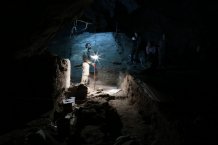Articles

Lapa do Santo 2014 Exhumation
DNA discovery gives new insight into ancient history of South America
The discovery of ancient DNA from the earliest inhabitants of South America has revealed important new information about how people settled in the Americas.
A major new study shows the first communities in Central and South America were descended from the first inhabitants of North America. But DNA shows this “genetic exchange” later came to an end, and experts have proved for the first time there was a complete population turnover in the continent.
The analysis of the remains of 49 individuals, some of which are more than 11,000 years old, was conducted by an international team of researchers. This shows the distinctive DNA type associated with the first inhabitants of North America – the Clovis culture – was also found in people living in Chile, Brazil and Belize 11,000 to 9,000 years ago. But later South Americans are not related genetically to these people – suggesting there was a complete population replacement.
Dr Mark Robinson, an archaeologist from the University of Exeter and member of the research team, said: “This research greatly enhances our understanding of the global human journey, revealing the population history of the last continent to be colonised by humans. The DNA data shows for the first time that the North American Clovis culture had a major demographic impact further south, but these early colonising genetic populations were completely replaced at least 9,000 years ago.”
The study, published in the journal Cell, was led by researchers at the University of Exeter, Harvard Medical School, the Howard Hughes Medical Institute, the Max Planck Institute for the Science of Human History, the University of California Santa Cruz, the Pennsylvania State University, the University of New Mexico, the University of São Paulo, and other institutions in Brazil, Belize, Chile, Argentina, Peru, the European Union and the United States.
Previously, the only genomes that had been reported from this region that provided sufficient quality data to analyse were less than 1,000 years old. The researchers obtained official permits to excavate and conduct analysis on ancient human remains, and consulted with local governmental agencies and indigenous communities. By comparing ancient and modern genomes from the Americas and other parts of the globe, they were able to gain new insights into the early history of Central and South America.
The remains of one individual from the Clovis culture living in North America around 12,800 years ago shares distinctive ancestry with the oldest remains found of people living in Chile, Brazil and Belize 9,000 years ago. This suggests the people who spread the Clovis culture in North America also reached Central and South America.
However later communities and present-day people in South America do not share the Clovis culture-associated ancestry that characterizes the oldest individuals. This shows there was a continent-wide population replacement that began at least 9,000 years ago.
The study also shows ancient Californians from the Channel Islands in the Pacific Ocean have a distinctive shared ancestry with groups living in the southern Peruvian Andes around 4,200 years ago. This may be due to the movement of people thousands of years earlier around the region rather than population spread specifically from the Channel Islands into South America. There is archaeological evidence that the population in the Central Andes area greatly expanded around 5,000 years ago.
To learn about the initial movements of people into Central and South America, it would be necessary to obtain ancient DNA from individuals dating to before 11,000 years ago and the researchers hope to examine more DNA data for the period between 11,000 and 3,000 years ago from Amazonia, northern South America and the Caribbean.
Co-senior author Johannes Krause of the Max Planck Institute for the Science of Human History said: “With future, regionally focused studies with large sample sizes, we could realize the potential of ancient DNA to reveal how the human diversity of this region came to be the way it is today.”
Reconstructing the Deep Population History of Central and South America is published in the journal Cell.
Date: 9 November 2018
